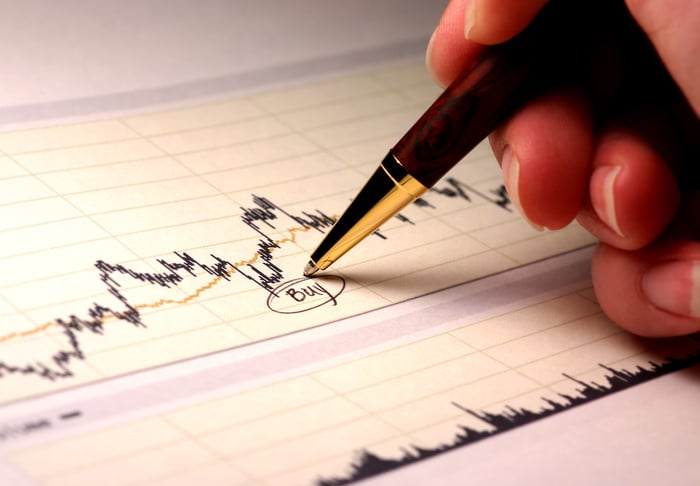When it comes to making money, Berkshire Hathaway (BRK.A 0.53%) (BRK.B 0.50%) CEO Warren Buffett is at the head of the class. Between 1965 and 2019, Buffett led Berkshire Hathaway's stock to an average annualized return of 20.3%. This equates to an aggregate 55-year return of 2,744,062%. It's created over $400 billion in value for the company's shareholders.
What's amazing about Buffett's success story is that he and his investing team haven't done anything that any retail investor couldn't themselves do. Berkshire Hathaway has deep pockets and can buy other businesses, but Buffett's ability to find businesses with plain-as-day competitive advantages, and his willingness to hang onto these investments over the long term, define his success.
You could also say that Warren Buffett's love of a bargain has driven his wealth creation. Right now, there are three stocks within Buffett's portfolio that are, in my opinion, absolute bargains.

Image source: Getty Images.
Wells Fargo
First up is money-center bank Wells Fargo (WFC 0.10%), which has had an exceptionally challenging couple of years.
"Cheap stocks" are generally cheap for a reason. That's the case with Wells Fargo. The company came clean about opening 3.5 million unauthorized accounts between 2009 and 2016. It is now dealing with the adverse effects of the coronavirus disease 2019 (COVID-19)-induced recession, including lower interest income and higher loan delinquencies.
Even accounting for its recent woes, Wells Fargo has a rich history of outperformance. In particular, it's always done an excellent job of courting affluent clientele. The rich are less likely to alter their spending habits or default on their loans during hiccups in the U.S. economy. They're also more likely to take advantage of multiple financial tools, such as asset management, credit services, and mortgages. Wells Fargo's return on assets has been superior among big bank stocks largely because of this well-to-do clientele.
Furthermore, Wells Fargo has levers it can pull to become more efficient. CEO Charles Scharf has plans to reduce annual operating expenses by about $10 billion. To achieve this, the company will lay off workers, consolidate duplicate platforms and processes, and promote digital and mobile banking.
Wells Fargo is an incredible bargain because of its price-to-book value of 74%. Excepting a few weeks in 2009, Wells Fargo has just about never been more of a bargain, based on its book value.

Image source: Getty Images.
Teva Pharmaceutical Industries
Another stock that can be placed in the bargain bin is brand-name and generic drug developer Teva Pharmaceutical Industries (TEVA 2.11%).
Perceived value stocks like Teva are usually in value territory for good reason. In Teva's case, it's a laundry list of reasons. The company overpaid for its Actavis acquisition in 2016 and ballooned its debt levels. It's also settled bribery allegations. It faces a handful of lawsuits over price fixing for generic drugs and its role in the opioid crisis.
It's easy to look past these challenges as short-term noise for Teva. It's one of the largest manufacturers of generic drugs. That puts it on track to benefit from a volume (and probably price) perspective as the world ages. Brand-name therapies aren't getting any cheaper, which will likely boost demand for generic drugs over the long haul.
CEO Kare Schultz's work is also exciting. Since taking over the reins in November 2017, Schultz has overseen a better than $10 billion reduction in net debt to under $24 billion. Teva has a real chance to reduce its net debt down to $15 billion by 2023. It will accomplish this by selling off noncore assets, reducing annual expenditures by $3 billion relative to where they were in 2017, and using some of the company's $2 billion-plus in annual operating cash flow to pay down debt.
Teva's investors are getting a drug developer currently valued at just 4 times Wall Street's per-share profit forecast for 2021. That's a bargain that should pay off for patient investors.

Image source: Getty Images.
Amazon
A final big-time bargain in Buffett's portfolio is e-commerce giant Amazon (AMZN -2.16%).
Amazon isn't what you'd call a traditional value stock. Its forward price-to-earnings ratio is about 70. It's valued at closer to 19 times its book value. Thankfully, book value and a P/E ratio aren't the only methods that can be used to evaluate a company.
In the case of high-growth companies like Amazon, which tend to reinvest a significant portion of their operating cash flow back into their business, I believe cash flow multiples provide much better measures of value. Over the last decade, Amazon has ended each year at between 23 and 37 times its operating cash flow per share. By 2023, Wall Street is counting on Amazon's operating cash flow to triple from its 2019 level. Based on its current price, we're talking about just under 14 times operating cash flow. Amazon has never been valued as cheaply as 14 times operating cash flow. That's what makes it such a bargain.
How can Amazon triple its operating cash flow in four years? Don't look to retail. Despite being the most dominant e-commerce company in the U.S., retail margins aren't that great, even with the aid of more than 150 million worldwide Prime memberships. Amazon's cash flow growth will derive mostly from its cloud infrastructure service segment, Amazon Web Services (AWS).
In the quarter ended in September, AWS had an annual run-rate of over $46 billion in sales. The margins for cloud infrastructure services are light-years better than online retail. As AWS grows into a larger share of total sales, Amazon's cash flow can skyrocket.





